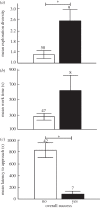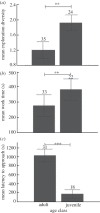Innovative problem solving by wild spotted hyenas
- PMID: 22874748
- PMCID: PMC3427591
- DOI: 10.1098/rspb.2012.1450
Innovative problem solving by wild spotted hyenas
Abstract
Innovative animals are those able to solve novel problems or invent novel solutions to existing problems. Despite the important ecological and evolutionary consequences of innovation, we still know very little about the traits that vary among individuals within a species to make them more or less innovative. Here we examine innovative problem solving by spotted hyenas (Crocuta crocuta) in their natural habitat, and demonstrate for the first time in a non-human animal that those individuals exhibiting a greater diversity of initial exploratory behaviours are more successful problem solvers. Additionally, as in earlier work, we found that neophobia was a critical inhibitor of problem-solving success. Interestingly, although juveniles and adults were equally successful in solving the problem, juveniles were significantly more diverse in their initial exploratory behaviours, more persistent and less neophobic than were adults. We found no significant effects of social rank or sex on success, the diversity of initial exploratory behaviours, behavioural persistence or neophobia. Our results suggest that the diversity of initial exploratory behaviours, akin to some measures of human creativity, is an important, but largely overlooked, determinant of problem-solving success in non-human animals.
Figures





References
-
- Reader S. M., Laland K. N. 2003. Animal innovation. Oxford, UK: Oxford University Press
-
- Kummer H., Goodall J. 1985. Conditions of innovative behaviour in primates. Phil. Trans. R. Soc. Lond. B 308, 203–21410.1098/rstb.1985.0020 (doi:10.1098/rstb.1985.0020) - DOI - DOI
-
- Morand-Ferron J., Quinn J. L. 2011. Larger groups of passerines are more efficient problem solvers in the wild. Proc. Natl Acad. Sci. USA 108, 15 898–15 90310.1073/pnas.1111560108 (doi:10.1073/pnas.1111560108) - DOI - DOI - PMC - PubMed
-
- Sol D., Duncan R. P., Blackburn T. M., Cassey P., Lefebvre L. 2005. Big brains, enhanced cognition, and response of birds to novel environments. Proc. Natl Acad. Sci. USA 102, 5460–546510.1073/pnas.0408145102 (doi:10.1073/pnas.0408145102) - DOI - DOI - PMC - PubMed
-
- Nicolakakis N., Sol D., Lefebvre L. 2003. Behavioural flexibility predicts species richness in birds, but not extinction risk. Anim. Behav. 65, 445–45210.1006/anbe.2003.2085 (doi:10.1006/anbe.2003.2085) - DOI - DOI
Publication types
MeSH terms
LinkOut - more resources
Full Text Sources

